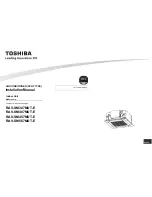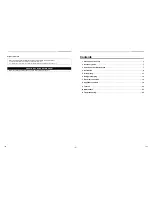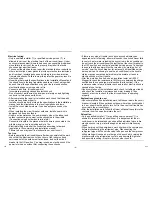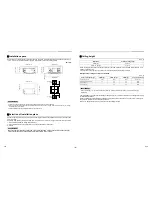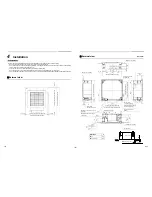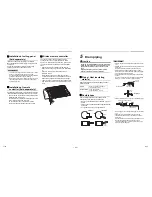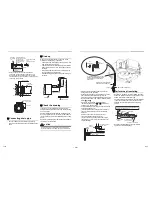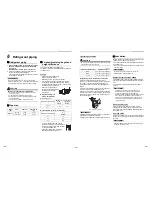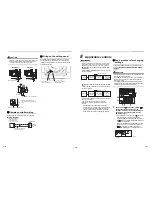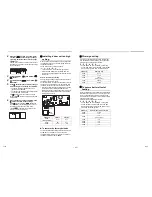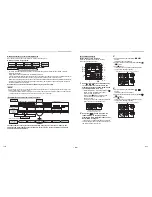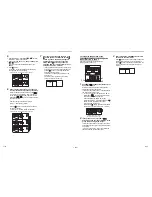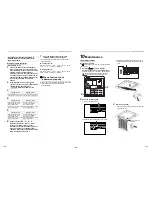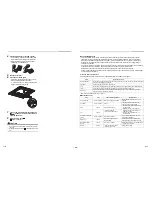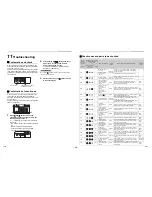
– 11 –
Installation of ceiling panel
(Sold separately)
Install the ceiling panel according to Installation
Manual attached with it after piping / wiring work has
completed.
Check that installation of indoor unit and ceiling
opening part is correct, and then install it.
REQUIREMENT
• Joint the connecting sections of ceiling panel, ceiling
surface, ceiling panel and indoor unit closely.
Any gap between them will cause air leakage and the
generate condensation or water leakage.
• Remove the adjust corner caps at the four corners of
the ceiling panel, and then install the ceiling panel
onto the indoor unit.
Installation of remote
controller (Sold separately)
For installation of the wired remote controller, follow the
Installation Manual attached with the remote controller.
• Pull out the remote controller cord together with the
refrigerant pipe or drain pipe.
Pass the remote controller cord through upper side
of the refrigerant pipe and drain pipe.
• Do not leave the remote controller at a place
exposed to the direct sunlight and near a stove.
Wireless remote controller
The sensor of indoor unit with wireless remote
controller can receive a signal by distance within
approx. 7 m. Based upon it, determine a place where
the remote controller is operated and the installation
place.
• Operate the remote controller, confirm that the
indoor unit receives a signal surely, and then install
it.
• Keep 1 m or more from the devices such as
television, stereo.
(Disturbance of image or noise may generate.)
• To prevent a malfunction, select a place where is not
influenced by a fluorescent light or direct sunlight.
• Two or more (Up to 6 units) indoor units with wireless
type remote controller can be installed in the same
room.
7 m
o
r le
ss
5
Drain piping
CAUTION
CAUTION
Following the Installation Manual, perform the drain
piping work so that water is properly drained, and
apply a heat insulation so as not to cause a dew
drop.
Inappropriate piping work may result in water
leakage in the room and wet of furniture.
Piping / Heat insulating
material
Require the following materials for piping and heat
insulating at site.
Flexible hose
Use the attached flexible hose to adjust centre
discrepancy of the hard vinyl chloride pipe.
• Do not use the flexible hose as stretched, or do not
deform.
• Fix the soft end of the flexible hose with the attached
hose band.
• Use the flexible hose on a horizontal level.
REQUIREMENT
• Perform heat insulation of the drain pipes of the indoor
unit.
• Perform heat insulation of the connecting part with the
indoor unit.
An incomplete heat insulation causes dew drop.
• Set the drain pipe with downward slope (1/100 or
more), and do not make swelling or trap on the piping.
It may cause an abnormal sound.
• For length of the traversing drain pipe, restrict to 20 m
or less.
In case of a long pipe, provide support brackets with
interval of 1.5 - 2 m in order to prevent waving.
• Set the collective piping as shown in the below figure.
• Do not apply force to the connecting part of the drain
pipe.
• The hard vinyl-chloride pipe cannot be directly
connected to the drain pipe connecting port of the
indoor unit.
For connection with the drain pipe connecting port, fix
the attached flexible hose with the hose band,
otherwise a damage or water leak is caused on the
drain pipe connecting port.
Piping
Hard vinyl chloride pipe VP20
(Outer dia.: Ø26 mm)
Heat insulator
Foam polyethylene:
Thickness 10 mm or more
Correct
Incorrect
Straight
Bend
(Trap)
Bend
Bend
Support
bracket
1/100 or more
downward
Heat insulator
1.5 - 2 m
Arched
shape
Trap
Incorrect
VP20
As long as possible (100 mm)
Downward slope
1/100 or more
VP30 or more
VP20
VP20
21-EN
22-EN
Содержание RAV-SM307MUT-E
Страница 28: ...EB99813501 ...

